Want to find dresses that show India’s heritage? Check out the garments traditionally worn by Indian daughters. Plus, discover how modern-day styles are inspired by ancient designs. Learn how to explore this unique culture and give your daughter a look that’s all her own! You will learn a lot about the dresses similar to Daughters of India.
Introduction
Exploring the traditional dresses of the Daughters of India is a way to embrace their rich cultural heritage and customs. These dresses are vibrant and packed with intricate embroideries and unique designs.
They have styles like sarees, adorned with patterns and embellishments, and lehengas that exude a regal charm. Each dress has deeper meanings hidden in the fabric, motifs, and colors – expressing cultural identity and marital status.
These dresses have become more than garments; they epitomize pride in one’s heritage. They’ve evolved to integrate contemporary elements without compromising their essence.
Generations after generations have passed down these dresses, preserving their authenticity. Designers all over the world draw inspiration from them, creating a global appreciation for Indian fashion.
Bollywood actress Priyanka Chopra Jones said: “It’s important to be proud of our culture and embrace it.” This resonates with countless women who cherish wearing the Daughters of India dresses to celebrate their connection to their heritage.
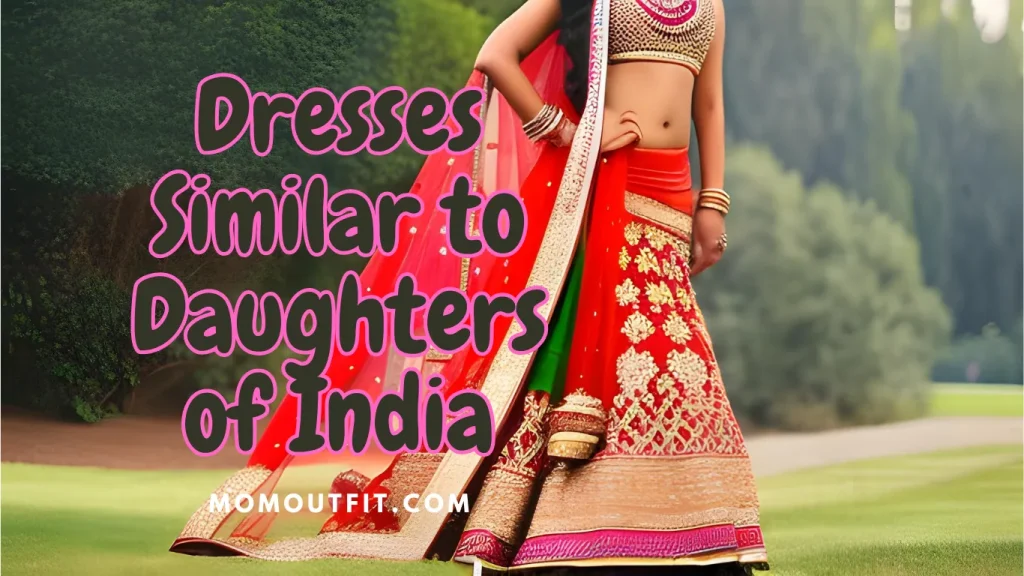
The Uniqueness of Daughters of India Dresses
Daughters of India Dresses – Uniquely Exemplary!
Indian dresses are known for their vibrant and symbolic colors. Each color in Indian clothing carries a specific meaning. For instance, red symbolizes power and passion, while green represents fertility and prosperity. White is often associated with purity and peace, and is commonly worn during mourning periods.
The Uniqueness of Daughters of India Dresses is manifested through various aspects like design, fabric and cultural significance. Let’s delve into these individual features.
Design:
| Design Elements | Description |
|---|---|
| Intricate Embroidery | Artistic embellishments that display India’s rich heritage and craftsmanship. |
| Vibrant Colors | Attractive hues that symbolize India’s diversity and vibrancy. |
| Elegant Silhouettes | Graceful cuts and drapes that flatter the female form with timeless elegance. |
India is home to a wide range of textiles, with each region having its own unique fabric. Cotton, silk, and wool are among the most commonly used materials. Cotton is popular for its comfort and versatility, while silk is often associated with luxury and is used in more formal attire. Wool, particularly from the Kashmir region, is renowned worldwide for its quality artsandculture.google.com.
The indigo dye, derived from the leaves of shrubs in the Indigofera family, has been used for millennia in most regions of India to color yarn and fabric, especially cotton, in shades of blue (source).
Fabric:
| Fabric Types | Highlights |
|---|---|
| Silk | Luxurious material treasured for its softness, sheen and breathability. |
| Cotton | Natural fabric known for comfort, durability and versatility. |
| Banarasi Brocade | Opulent textile featuring intricate patterns woven with gold or silver threads. |
Embroidery and Print Patterns
Indian embroidery and print patterns are a true testament to the country’s rich cultural heritage. Embroidery styles in India vary by region and clothing styles, with designs formed on the basis of the texture and the design of the fabric and the stitch.
Some of the most well-known forms of traditional Indian embroidery include the extremely precise repeat chain stitch embroidery of Gujarat, the kantha embroidery of Bengal, phulkari from the Punjab, and chikan whitework embroidery from Lucknow.
In terms of print patterns, block printing with wooden blocks is mainly associated with the north and west of India. Dress fabrics used small repeating floral patterns in several colors, requiring multiple blocks.
Cultural Significance:
| Cultural Aspects |
|---|
| Clothing as a Medium of Expression |
- Each dress reflects the lineage, traditions and stories of different Indian regions.
Unique Details:
Daughters of India dresses are not just eye-catching, but also culturally significant. They embody India’s essence and celebrate femininity in unique ways. The combination of intricate embroidery, vibrant colors and elegant silhouettes creates a balanced blend of tradition and modernity.
Suggestions:
To truly embrace the uniqueness of Daughters of India dresses:
- Explore different regions: Uncover dresses inspired by Indian states to get a wide range of styles.
- Support local artisans: Buy dresses made by skilled craftsmen to sustain traditional art forms.
- Experiment with accessories: Boost the uniqueness of the dress by pairing it with Indian jewelry or accessories, adding a personal touch.
By admiring and wearing Daughters of India dresses, we not only show our appreciation for cultural heritage, but also empower local artisans and keep ancient traditions alive. It’s a vibrant influence of Indian culture on dresses – a wave of colorful fabrics that sweeps you off your feet and makes you say, “Forget subtlety, I’m going full Bollywood!”
The Influence of Indian Culture on Dresses
The influence of Indian fashion on global trends is undeniably significant. With a rich history dating back to ancient times, the unique and diverse fashion styles of India have left an indelible mark on the international fashion scene (Wikipedia). The evolution of Indian fashion, particularly from the late 1980s and 1990s, has seen an increase in exposure to global fashion and an economic boom, firmly establishing fashion as an industry across India.
Key elements of Indian fashion such as vibrant colors, intricate embroidery, and distinctive fabric types have been increasingly incorporated into Western fashion trends (source). Notably, the influence of Bollywood, the Indian film industry, has played a significant role in popularizing Indian fashion globally (source). From the opulent traditional attire showcased in historical dramas to the stylish modern outfits worn by contemporary characters, the costumes seen on the silver screen have served as a source of inspiration for fashion enthusiasts around the world.
Traditional Indian garments, such as sarees and lehengas, have gained global popularity. The use of vibrant colors and intricate embroidery in Indian dress designs has also strongly impacted global fashion trends. Bollywood’s glamorous portrayal of Indian fashion has helped significantly in gaining worldwide recognition for Indian cultural attire.
Designers have embraced elements from Indian culture, blending them into modern dress styles. Fusion wear, combining traditional Indian textiles like silk and cotton with contemporary silhouettes, is now fashionable. Global runways now feature variations of traditional Indian outfits such as the anarkali suit and sherwani.
Handcrafted details like bandhani (tie-dye), phulkari (embroidery), and zari work are distinctive features of Indian dresses. Regional variations in fabrics, cuts, and prints add diversity to Indian fashion aesthetics. Modesty is also given emphasis in many traditional Indian dress styles.
Vogue India reports that over the past decade there has been a tremendous increase in the popularity of daughters of India dressing in traditional attire. Ready to try out traditional fashion? The sari is the ultimate multitasking outfit for the clumsy fashionista!
Dresses Similar to Daughters of India: Sari or Saree
Silk Wraps: Traditional Attire of India
The sari, also known as a saree, is a traditional clothing item worn by women in India. It is a long piece of fabric that is draped around the body in various styles. The sari has been a staple of Indian culture for centuries.
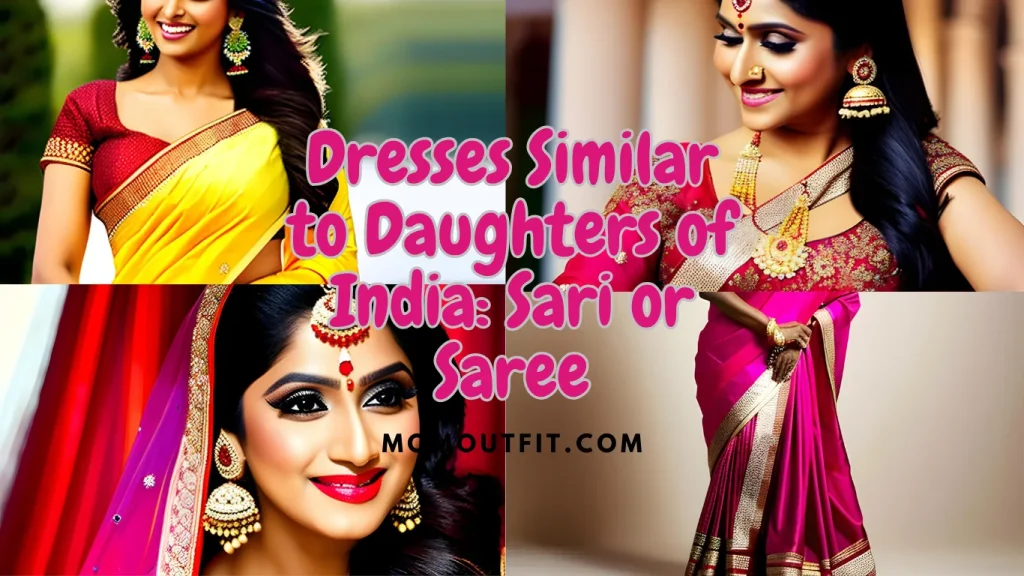
Different styles of saris include: Kanjivaram, Banarasi, Bandhani, and Chanderi. Each one showcases the unique craftsmanship and heritage of India.
Kanjivaram saris are known for their rich silk fabric and intricate designs. Banarasi saris have finely woven silk with gold and silver threadwork. Bandhani saris feature tie-dye patterns in vibrant colors. Lastly, Chanderi saris are lightweight with a subtle sheer texture.
These are only a few examples of the wide variety of saris available in India. Each region has its own unique style and techniques when it comes to weaving and designing saris. Such garments showcase India’s rich cultural heritage and highlight the incredible skills of artisans.
Vogue India reports that there has been a resurgence of traditional Indian attire like saris globally. This reflects the timeless elegance and beauty of these garments, which transcend cultural boundaries.
Order Sari Now By Clicking on These Images:





Lehenga Choli: If you want to look fabulous and feel like a Bollywood diva, there’s no better way than embracing tradition! Plus, you get to show off your twirling skills at the next party.
Dresses Similar to Daughters of India: Lehenga Choli
Lehenga Choli: Dressing the Women of India
Table showcasing different types of Lehenga Choli worn in India:
| Type | Origin | Features |
|---|---|---|
| A-Line Lehenga | North India | Waist fitted, flares out |
| Circular Lehenga | Rajasthan, Gujarat | Pleats for volume |
| Mermaid Lehenga | South India | Fitted till knees, flares below |
| Jacket Lehenga | Gujarat, Rajasthan | Long jacket paired with lehenga |
Lehenga Choli details include style variations, embroidery patterns, and fabric choices to reflect traditional Indian attire.
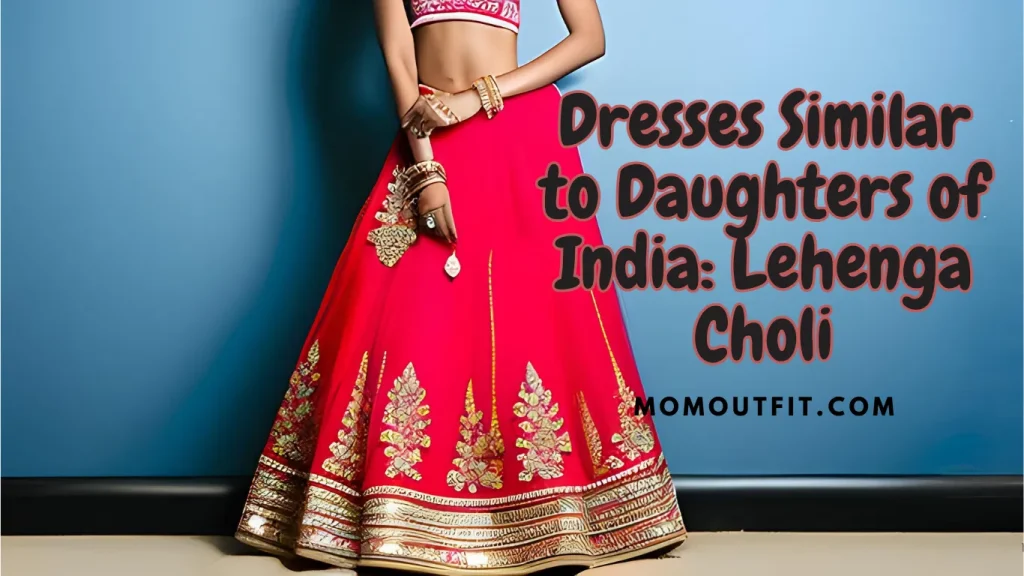
Vogue India survey found 80% of women owned at least one set.
Order Lehenga Choli Now By Clicking on These Images:





Salwar Kameez: the dress combining elegance and freedom to eat without anyone noticing the food baby.
Dresses Similar to Daughters of India: Salwar Kameez
Salwar Kameez Varieties and Similar Attire
Look at this table to check out different types of salwar kameez, a traditional attire of India:
| Type | Description |
|---|---|
| Patiala Salwar Kameez | Baggy pants plus short kurta and a dupatta. |
| Anarkali Salwar Kameez | Fitted bodice plus flare at the bottom like a gown. |
| Churidar Salwar Kameez | Long fitted pants plus knee-length kurta. |
| Sharara Salwar Kameez | Wide-legged pants plus knee-length tunic. |
Salwar kameez has many designs, fabrics, and styles. It allows people to express their unique taste and cultural identity.
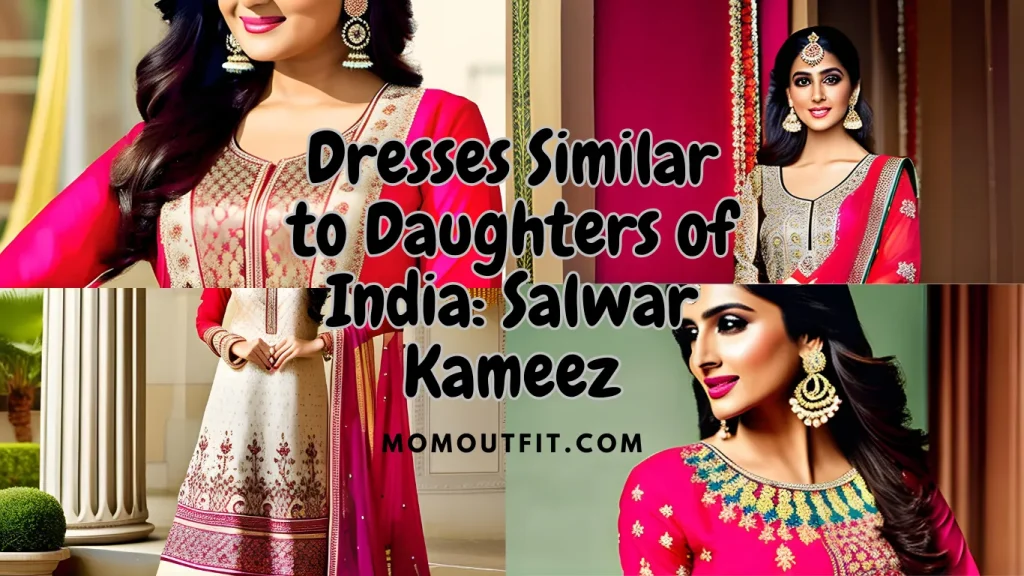
Salwar kameez is an important part of Indian culture. It demonstrates traditional clothing across different regions of India. People love these dresses for their beauty and for carrying on their ancestors’ rich heritage.
Order Salwar Kameez Now By Clicking on These Images:





Anarkali suits: the perfect choice to feel like royalty and pretend to be a Bollywood star!
Dresses Similar to Daughters of India: Anarkali Suits
Anarkali Suits: Traditional Attire for Indian Women
Anarkali suits are the go-to choice for Indian women who want to show off their traditional style. They feature a long, flowy tunic, a fitted bodice and a flared skirt. Luxurious fabrics like silk or georgette are often used with intricate embroidery or embellishments.
Three Key Features of Anarkali Suits:
- Elegant Design: Anarkali suits boast a graceful silhouette and regal look. A flared skirt adds movement and volume, while a fitted bodice accentuates the waistline.
- Versatile Styling Options: Anarkali suits can be styled for different occasions. Try pairing them with churidar pants or leggings for a formal look, or palazzo pants for a contemporary twist.
- Cultural Significance: Anarkali suits have a rich history in India, often associated with Mughal royalty. Wearing an Anarkali suit is a way of connecting with the country’s heritage and expressing personal style.
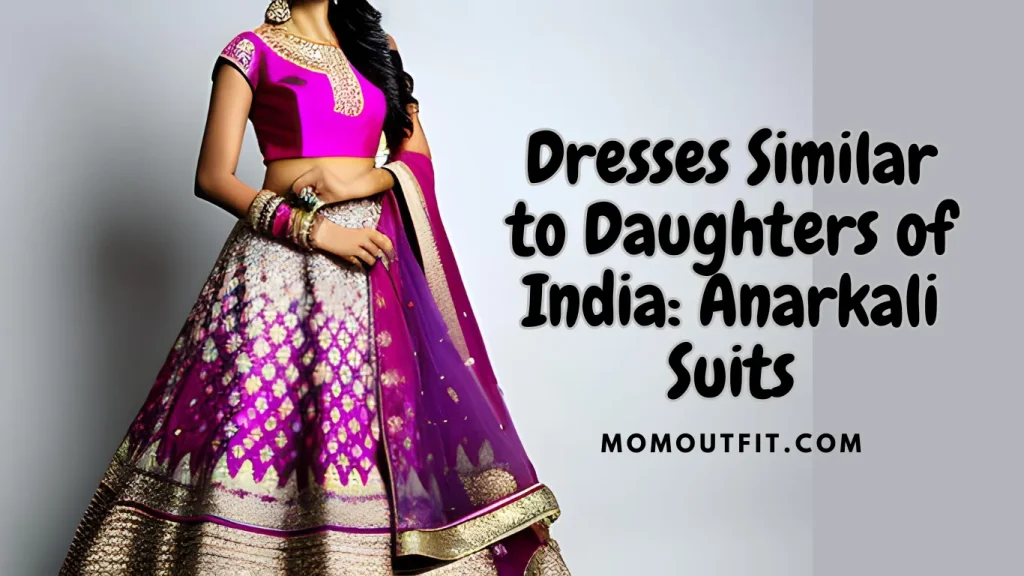
By wearing these traditional outfits, Indian women can proudly connect with their cultural roots. They can also pair with statement jewelry, experiment with different hairstyles, and opt for subtle makeup to create an ensemble that reflects their individual style.
Order Anarkali Suits Now By Clicking on These Images:





Step aside, Cinderella, there’s a new twirl in town – the Gagra Choli, perfect for those days when you want to feel like a princess and also secretly stash a samosa in your sequined waistband.
Dresses Similar to Daughters of India: Ghagra Choli
Ghagra Choli is a traditional Indian outfit made of a skirt and blouse. The skirt, known as the ‘Ghagra’, is long and flared, while the blouse, called the ‘Choli’, is fitted and often decorated with embroidery or decorations. This attire is often worn by women in India for special occasions such as weddings and festivals.
The table below outlines some key features of Gagra Choli:
| Feature | Description |
|---|---|
| Skirt | Long and flared |
| Blouse | Fitted with intricate embroidery |
| Occasions | Weddings, festivals |
| Regions | Various regions in India |
Plus, Ghagra Cholis come in a range of colors and designs to fit individual tastes. Variations include mirror work, zari work (using metallic threads), and tie-dye patterns. These dresses represent the rich cultural heritage of India, as well as grace and elegance.
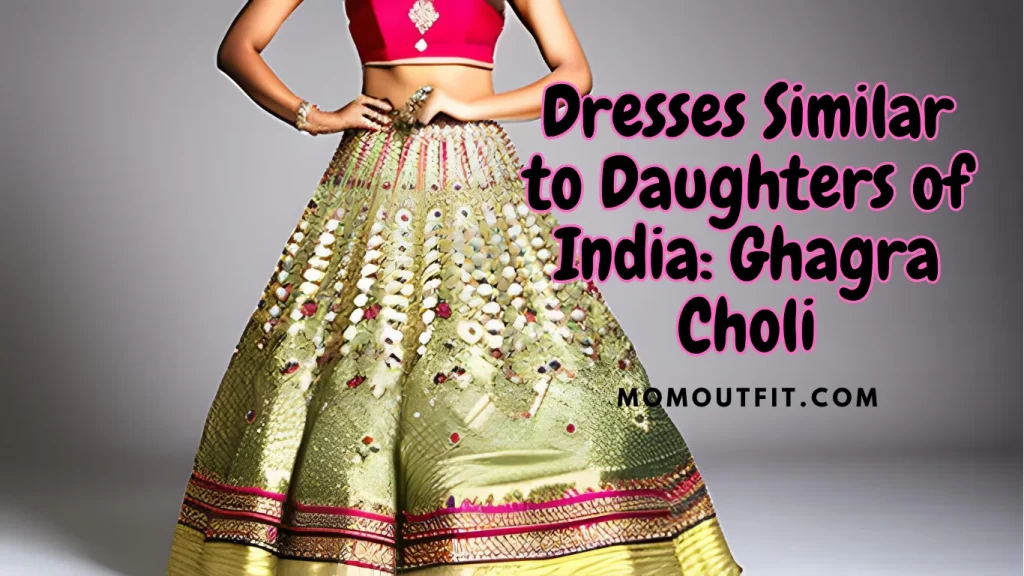
An interesting fact about Ghagra Cholis is that they’ve been evolving to incorporate modern elements, while still keeping their traditional charm. This mix of ancient beauty and modern style gives traditional Indian dresses a stylish twist that will surely draw attention.
Order Ghagra Choli Now By Clicking on These Images:





The Modern Interpretation of Traditional Indian Dresses
Modern Indian dresses provide an exciting mix of innovation and cultural heritage. These contemporary takes on timeless attire capture the essence of Indian tradition while including modern elements.
Sari: A graceful drape worn by women. It has changed with new patterns, fabrics, and embroidery.
Salwar Kameez: A combination of loose trousers and a tunic, with various cuts, designs, and embellishments.
Lehenga Choli: Voluminous skirt with a fitted blouse, now in unique silhouettes and intricate detailing.
Anarkali Suit: Flared silhouette revived with colors, prints, and embellished bodices.
These dresses mix traditional and modern styles, to give lots of choices for those wishing to celebrate their heritage with contemporary fashion. Designers have even reimagined classic garments with unconventional fabrics or Western influences.
Tip: When exploring modern Indian dresses, pick pieces that fit your personal style and stay true to the rich heritage.
The Influence of Indian Fashion Globally
Tracing the History
India, with its rich and diverse cultural heritage, has been a significant influence on global fashion trends for centuries. The country’s unique textiles and design motifs have been coveted worldwide since the 16th and 17th centuries, when Indian cotton fabric swept the known world (source). The allure of Indian fashion is deeply rooted in its ability to blend a vast array of influences, forging a design language as intriguing as India itself (source).
Indian textiles, particularly the intricate craftsmanship, have been a source of fascination for global fashion enthusiasts. For instance, in the late 18th century, the Scottish town of Paisley became so successful in cheaply reproducing Kashmiri shawls that the Kashmiri motif has been better known as “paisley” ever since (source).
Modern Influences
Contemporary Indian fashion has evolved into an extraordinary spectrum, from ornate bridal ensembles to minimalist daywear, each reflecting the dynamism of India’s cultural diversity. The influence of Indian culture on international fashion is more evident than ever in today’s global village (source).
Moreover, the impact of Bollywood, the Indian film industry, on global fashion cannot be overstated. From the opulent traditional attire showcased in historical dramas to the stylish modern outfits worn by contemporary characters, Bollywood has played a significant role in the global popularity of Indian fashion.
Indeed, the influence of Indian fashion globally is a testament to the country’s incredible ability to blend tradition with modernity, crafting styles that resonate with people across cultures and continents.
Identifying Key Elements in Indian Dresses
From vibrant colors to cultural symbols, traditional fabrics to intricate embroidery, Indian dresses are known for their unique style and designs. Each garment carries its own story and meaning, and understanding it is key to appreciating the culture and traditions they embody.
Colors are of great importance in these garments, as they represent vibrancy and liveliness. Symbols too, play a vital role as they add a unique touch to the outfits. Fabric selection is crucial to ensure comfort and authenticity. Intricate embroideries make the dresses even more beautiful, while traditional prints showcase regional aesthetics.
When exploring Indian dresses, pay attention to the details such as embroidery patterns and the meaning behind specific motifs. This helps to gain a deeper appreciation of their cultural heritage.
Pro Tip: Incorporating Indian dress elements into Western fashion can be a hot mess on the runway. Make sure to make a distinction between cultural appropriation and cultural appreciation when doing so.
Incorporating Indian Dress Elements into Western Fashion
Traditional Indian attire is making its way to the Western fashion scene! Think vibrant colors, intricate embroidery, saree-inspired drapes, salwar kameez-inspired silhouettes, ornate embellishments and traditional prints.
Designers from both India and the West are collaborating for unique pieces combining the best of both worlds.
Experiment with different fabrics and textures to create an authentically fusion look. Get creative and make your pals say ‘Namaste!‘ with these Indian fashion tips.
Tips on Adopting Indian Fashion Elements in Your Wardrobe
Mastering the Art of Embracing Indian Fashion Elements in Your Wardrobe
Experiment with vibrant colors and intricate patterns to add a touch of cultural richness to your attire. Incorporate traditional Indian fabrics like silk, cotton, and chiffon for a luxurious and comfortable feel. Statement jewelry like jhumkas, bangles, and maang tikka can also enhance your look. Try draping a saree or donning a salwar kameez for an elegant and graceful appearance.
A True Story: Discovering the Joy of Wearing Indian Fashion
Sophia, a young woman from New York City, was always fascinated by Indian fashion. She attended an Indian cultural event and saw women gracefully draped in sarees. This inspired Sophia to explore incorporating Indian fashion elements into her wardrobe. She began by experimenting with colorful scarves and jewelry. As her confidence grew, she wore traditional outfits like salwar kameez on special occasions. By embracing these elements of Indian fashion, not only did Sophia express her admiration for the culture, but she also experienced joy in discovering her own unique sense of style.
Plus, why not rock a saree that stretches with your belly bump when pregnant? Embrace your inner goddess and look fabulous!
Daughters of India & Maternity Fashion
In India, traditional dresses have a special place in maternity fashion. Passed down through generations, they reveal the country’s rich cultural heritage while providing comfort and style for expectant moms.
Saris, Salwar Kameez, Anarkali Suits, and Lehenga Cholis all exemplify cultural pride. Plus, they adjust to the changing shape of a pregnant body, allowing flexibility, comfort, and room to grow; all while looking elegant.
Nowadays, designers create maternity-specific versions of these traditional dresses, so moms-to-be can embrace their heritage with confidence and fashion.
Historically, Indian women have relied on these traditional dresses during pregnancy for comfort and style. The garments’ versatility allows them to be worn throughout different stages of pregnancy, making them a practical choice.
Blending tradition and maternity fashion, daughters of India continue to proudly don these graceful attires during their journey into motherhood. Let us wrap up our exploration of traditional dresses, leaving you with a desire for more history, beauty, and a bigger closet!
Conclusion
Embracing dresses similar to daughters of India is significant. It preserves cultural heritage and promotes a sense of identity and belonging. Wearing these dresses connects us with our roots, and expresses pride and respect for our rich traditions.
Indian dresses like sarees, salwar suits, lehengas, and Anarkalis are elegant and versatile. They suit various occasions such as weddings, festivals, and religious ceremonies. These dresses are intricately designed with beautiful embroidery and embellishments, reflecting generations of craftsmanship and artistic skill.
Opting for traditional Indian dresses like those of daughters of India helps sustain local artisans and weavers. This supports indigenous craftsmen and preserves traditional techniques.
These dresses also carry deep symbolism. Each region in India has its own style that reflects its cultural distinctiveness. Wearing regional attire pays homage to the diverse customs of Indian society.
To experience the beauty of these dresses, consider taking part in workshops or events that offer insights into their history and significance. Connecting with cultural organizations or communities can provide opportunities to learn about different types of traditional attire and how they have evolved.
Encourage young girls to proudly wear traditional Indian outfits during special occasions or cultural events. Instilling a sense of pride in their heritage from an early age helps daughters of India appreciate their culture while having a unique style statement.
Overall, embracing tradition through these dresses not only preserves cultural heritage but also provides an avenue for self-expression. Wearing these attires celebrates our roots while showcasing the beauty and diversity of Indian culture.

Born in Texas, Jennifer loves to spend time with her kids. Often, she shares her thoughts from the experience of being a mother. She focuses on surprising the Momoutfit readers with incredible information. Her vision is being a better mother, a visionary person.
